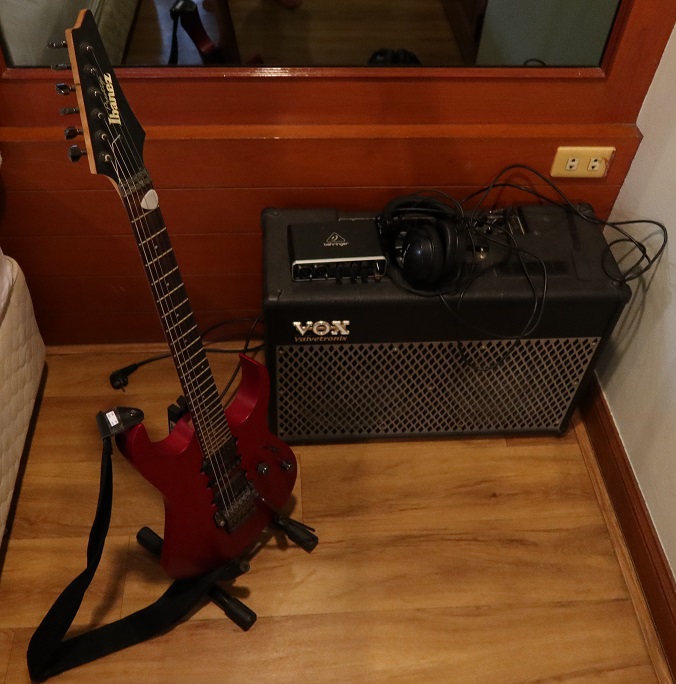Sound Engineering the Guitar
The goal of this inquiry seminar is to explore the world of guitar recording and achieve a better sound presentation.
Contents
Background
Previous Background with Music
I started playing in 6th grade and developed a taste for heavy metal and guitar focused songs. This includes Canon Rock by Jerry C, Cliffs of Dover by Eric Johnson, Jordan by Buckethead, and Scarified by Paul Gilbert. Unfortunately, by the time 9th grade came along I would have stopped playing guitar.
I would re-find the spark in my 3rd year at WPI. I finally got myself a decent digital analog to digital converter. I found myself interested in 90’s and 00’s alternative rock, as well as a lot of Japanese rock music. From then on, I have been making song covers occasionally and uploading to YouTube. As such, I took the opportunity to explore Music through WPI's music catalog.
In D-term of 2020, when COVID-19 terrorized the world, I found myself taking two WPI music classes: MU2300 (Foundations of Music Technology) and MU3615 (Topics In Digital Sound). I was introduced to Ableton, and I finally found a replacement for Audacity for sound engineering. This perhaps was a huge turning point in my career, as I was about to level up the sound quality of my guitar covers.
Motivation
Having gotten into creating song covers and learning the new tool that is Ableton, this inquiry seminar became a way to push my knowledge and ability of both of these skills to the next level. I find myself struggling with EQ and Compression Manipulation, and found it difficult to differentiate between good EQ engineering and poor EQ engineering.
Equipment
- Ibanez Prestige Electric Guitar
- Behringer U-Phoria UMC2-2HD Audio Interface
- DT770 Beyerdynamic Headphones
Getting the Right Tone
Understanding Amps
For the first part of the inquiry seminar, I explored briefly into some general principles of an amplifier
Tube Amps vs Solid State Amps
Tube amps and solid state amps differ in their methods of amplification. While tube amps are voltage driven, solid state amps are current driven. The general result is that tube amps amplifies greater texture, whereas solid state amps amplifies greater power and detail. From listening to a few examples, the tube amp complements nicely with bluesy styles due to its richer texture and dynamic range, while solid state amps are more suitable for rock or metal.
Impedance
Impedance levels indicate the levels at which sound can pass through. Prof. Manzo's textbook mentions three levels: Line level, Microphone Level, and Instrument Level, ordered by the levels. For example, plugging in a microphone will result in barely any sound, since the impedance level of the microphone is higher than the line level. On the other hand, plugging a microphone into the instrument level will resort in distortion.
Impulse Response
Impulse Response is a way to recreate the sound of a rig set-up. This is done by recording the existing rig into the computer, and using an impulse response software to transform the signal.
Recreating the Tone: Separate Ways
As an introduction to sound engineering, I worked on recreating the sound of the synthesizer from the intro of Journey's Separate Ways in Ableton. I used two sawtooth oscillators in sub-oscillator mode, and I de-tuned the second oscillator to achieve a slight phase effect. Then the signal chain follows through to the Equalizer and the Reverb. For the equalizer, I did recognize the need to control lower frequencies, but failed to recognize the same for higher frequencies. This led to issues with the tone that will be fixed later on.
Into getting a great Guitar Tone
General Guidelines
A common trait seen in teenage guitarists is their affinity to crank up the distortion to the max and rock out with no sense for tone. Of course, I am guilty of this as well in my middle school years. Of course, good sound comes from more than just distortion. Normalization, equalization, and compression are also very big ideas that need to be taken into account. A few guide lines that I learned were
- Normalization is required to make sure the volume is never unintentionally clipped
- Compression should be applied at the mastering stage, after maxing out the volume
- Analog equipment (as opposed to VSTs) can give a ‘warmer sound’. There may be incentive to invest in actual physical gear, rather than just relying on digital effects simulators.
PositiveGrid’s BiasFX and BiasAmp
As per reccomendation of Prof. Manzo, PostivieGrid's BiasFX and BiasAmp are excellent VST's to help in creating professional grade guitar tones. With these two VST's a complete customization of the signal chain from start to finish can be achieved. It also comes with pre-customized packages, from default presets for a quick ballpark tone to downloadable fully designed signal chains that mimics signature sounds of famous guitarists.
Recreating the Tone: Highway Star
<embedvideo service="youtube">https://www.youtube.com/watch?v=StPSujfX0YI</embedvideo>
